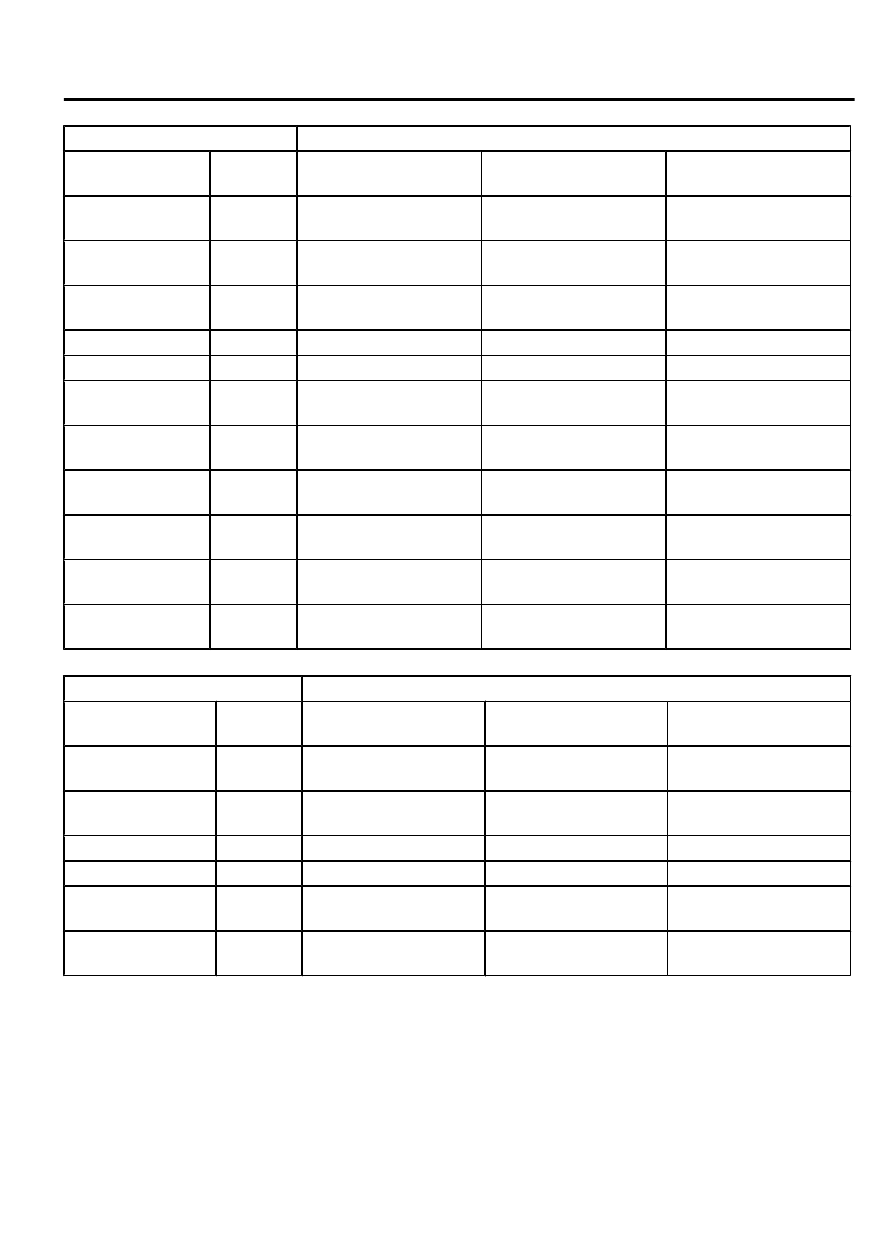Mitsubishi Outlander XL. Manual - part 60

STANDARD BOLT AND NUT TIGHTENING TORQUE
Thread size
Standard tightening torque
Nominal
bolt
diameter (mm)
Pitch
(mm)
Head mark "4"
Head mark "7"
Head mark "8"
M5
0.8
2.5 ± 0.5 N·m (23 ± 4 in-
lb)
5.0 ± 1.0 N·m (44 ± 9 in-
lb)
6.0 ± 1.0 N·m (53 ± 9 in-
lb)
M6
1.0
5.0 ± 1.0 N·m (44 ± 9 in-
lb)
8.5 ± 1.5 N·m (76 ± 13
in-lb)
10 ± 2 N·m (89 ± 17 in-
lb)
M8
1.25
11 ± 2 N·m (98 ± 17 in-
lb)
20 ± 4 N·m (15 ± 3 ft-lb) 24 ± 4 N·m (18 ± 3 ft-lb)
M10
1.25
23 ± 4 N·m (17 ± 3 ft-lb) 42 ± 8 N·m (31 ± 6 ft-lb) 53 ± 7 N·m (39 ± 5 ft-lb)
M12
1.25
42 ± 8 N·m (31 ± 6 ft-lb) 80 ± 10 N·m (59 ± 7 ft-lb) 93 ± 12 N·m (68 ± 9 ft-lb)
M14
1.5
70 ± 10 N·m (52 ± 7 ft-lb) 130 ± 20 N·m (96 ± 15 ft-
lb)
150 ± 20 N·m (111 ± 14
ft-lb)
M16
1.5
105 ± 15 N·m (78 ± 11 ft-
lb)
195 ± 25 N·m (144 ± 18
ft-lb)
230 ± 30 N·m (170 ± 22
ft-lb)
M18
1.5
150 ± 20 N·m (111 ± 14
ft-lb)
290 ± 40 N·m (214 ± 29
ft-lb)
335 ± 45 N·m (247 ± 33
ft-lb)
M20
1.5
210 ± 30 N·m (155 ± 22
ft-lb)
400 ± 60 N·m (295 ± 44
ft-lb)
465 ± 65 N·m (343 ± 48
ft-lb)
M22
1.5
290 ± 40 N·m (214 ± 29
ft-lb)
540 ± 80 N·m (398 ± 59
ft-lb)
630 ± 90 N·m (465 ± 66
ft-lb)
M24
1.5
375 ± 55 N·m (277 ± 40
ft-lb)
705 ± 105 N·m (520 ± 77
ft-lb)
820 ± 120 N·m (605 ± 88
ft-lb)
FLANGE BOLT AND NUT TIGHTENING TORQUE
Thread size
Standard tightening torque
Nominal
bolt
diameter (mm)
Pitch
(mm)
Head mark "4"
Head mark "7"
Head mark "8"
M6
1.0
5.0 ± 1.0 N·m (44 ± 9 in-
lb)
10 ± 2 N·m (89 ± 17 in-
lb)
12 ± 2 N·m (107 ± 17 in-
lb)
M8
1.25
13 ± 2 N·m (111 ± 22 in-
lb)
24 ± 4 N·m (18 ± 3 ft-lb) 28 ± 5 N·m (20 ± 4 ft-lb)
M10
1.25
26 ± 5 N·m (19 ± 4 ft-lb) 50 ± 5 N·m (37 ± 4 ft-lb) 58 ± 7 N·m (43 ± 5 ft-lb)
M10
1.5
25 ± 4 N·m (18 ± 3 ft-lb) 46 ± 8 N·m (34 ± 6 ft-lb) 55 ± 5 N·m (41 ± 3 ft-lb)
M12
1.25
47 ± 9 N·m (35 ± 6 ft-lb) 93 ± 12 N·m (68 ± 9 ft-
lb)
105 ± 15 N·m (78 ± 11
ft-lb)
M12
1.75
43 ± 8 N·m (32 ± 6 ft-lb) 83 ± 12 N·m (61 ± 9 ft-
lb)
98 ± 12 N·m (72 ± 9 ft-
lb)
LUBRICATION AND MAINTENANCE
M10001000012USA0000010000
Maintenance
and
lubrication
service
recommendations have been compiled to provide
maximum protection for the vehicle owner's
investment against all reasonable types of driving
GENERAL <BODY AND CHASSIS>
00-49
LUBRICATION AND MAINTENANCE